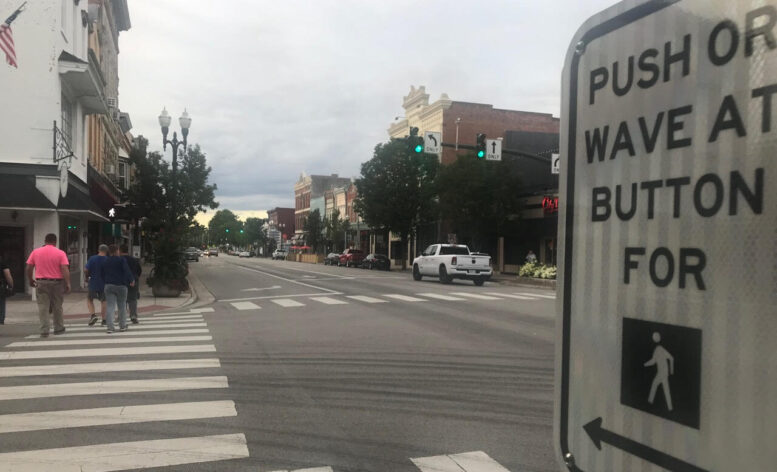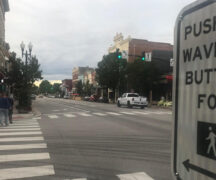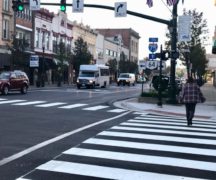By JAN McLAUGHLIN
BG Independent News
In the past decade, 103 pedestrians have been hit by motor vehicles in Bowling Green. During that same period, 73 bicyclists have been struck by vehicles.
Of those 176 reported crashes, two were fatal for the pedestrians, and one was fatal for the bicyclist, according to Bowling Green Police Chief Deputy Adam Skaff.
To make the city safer to navigate, a walk audit is being planned – and volunteers are being sought to don reflective vests and carry clipboards.
The walk audit will be conducted by BG Save Our Neighborhoods Group and its Transportation and Mobility Action Team, with the assistance of city government.
The audit will assess the walkability of the city by recording several factors that might be barriers to pedestrians, such as traffic lights that change too quickly, or the lack of crosswalks, curb cuts or sidewalks.
The volunteers who sign up to help will undergo basic training prior to the audit, according to Debbie Thompson, a member of the Transportation and Mobility Action Team.
Local input is also being sought from BG residents on specific streets or intersections that should be studied in the audit. It is likely a second audit will be conducted in the fall once BGSU is back in session, Thompson said.
More information will be forthcoming on the walk audit dates, how to volunteer, and how to submit areas to be audited.
The local survey will use a walk audit toolkit created by the American Association of Retired People to tackle the following problems identified by AARP:
- Too many communities are designed exclusively, or almost exclusively for automobile travel.
- Little consideration is given to pedestrians.
- Preventing people from walking are: multi-lane roadways, high speed corridors unsafe to cross, lack of street maintenance and lack of sidewalks.
Between 2010 and 2019, drivers in the U.S. struck and killed 53,435 pedestrians – an average of 14 people a day, according to Smart Growth America’s 2021 “Dangerous by Design” report.
In 2017, an estimated 137,000 pedestrians were treated in emergency rooms for non-fatal crash-related injuries, according to the Centers for Disease Control & Prevention.
According to AARP, local leaders and residents can help make neighborhoods more walkable by conducting a walk audit to identify the roads and intersections that should be walkable and crossable, but are instead dangerous by design for pedestrians.
A walk audit can:
- Gather input about community infrastructure needs and investments.
- Educate residents about design elements that support safety.
- Empower community members and local leaders to become agents of change.
A walk audit can lead to:
- Reduced traffic congestion and pollution.
- Healthier, more active lifestyles.
- Increased property values.
- Safer streets for people of all ages.
The findings of the audit will be presented to City Council.
Last year, in an effort to make parents more comfortable allowing their children to walk or bike to school, Bowling Green City Council adopted a plan for a Safe Routes to School Program.
As part of that plan, two infrastructure “countermeasures” were approved as the first of a long list of suggested steps.
First is the shared use path that the city has been planning between Crim Elementary School and Carter Park.
The second project will be pedestrian hybrid beacons added to two crosswalks, one at East Wooster and Enterprise streets, and one on West Poe Road near Darlyn Avenue, in front of the high school.
Those type of pedestrian beacons are currently in use on East Wooster Street, in front of Panera and between Manville and South College Drive.
The city is currently working on a pedestrian hybrid beacon at the intersection of West Wooster Street and Maple Street.
These projects were selected from a long list of countermeasures identified during the planning process for the Safe Routes plan, according to Bowling Green City’s Public Works Director Mick Murray.
The plan includes 37 countermeasures involving infrastructure additions, such as sidewalks, street crossing beacons, shared use paths, better signage or traffic flow evaluations. The plan also includes 28 non-infrastructure measures involving education, encouragement, enforcement or engineering.
Last year, the city also installed new sidewalks, curbs, and curb ramps at the Sand Ridge and South Maple intersection in preparation for a rapid flash beacon crosswalk, identified as a need in the Safe Routes to School Study.
The city also secured funding assistance to install a shared use path along Brim Road, connecting the Bowling Green High School to the Community Center and Cogan’s Crossing, a shared use path along South Main Street as part of the infrastructure improvement project, a shared use path along North Main Street, as part of a joint Safe Routes for All regional partnership.
The project on South Main Street, will include a shared use path being built along the west side of South Main (from Gypsy Lane to Napoleon Road), along with ADA ramp improvements, traffic signal replacement and road widening at the South Main/Napoleon Road intersection, and the installation of two pedestrian hybrid beacons between Gypsy Lane and Napoleon roads.



